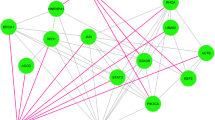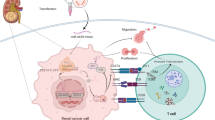Abstract
Background
Cervical cancer (CC) remains a large burden in the developing countries. The tumor inhibitory role of miR-873 has been verified in a variety of cancers, however, whether miR-873 has a suppressive effect on CC remains unclear.
Objective
The purpose of this study was to investigate the functional role of miR-873 in CC, as well as explore the underlying molecular mechanism.
Methods
The prognostic values of miR-873 were assessed by Kaplan–Meier methods and cox regression models using the data which were downloaded from TCGA database. The expression of miR-873 was measured by RT-qPCR. Cell counting Kit-8, clone formation, and Transwell assays were used to assess the cell viability and metastasis, appropriately. The targeting relationship between miR-873 and ULBP2 was predicted by biological software and confirmed by dual luciferase reporter assay. Rescue assays were conducted to investigate whether miR-873 affects the phenotype of CC cells via regulating ULBP2.
Results
We observed that miR-873 was low-expressed in CC. Up-regulation of miR-873 notably restrained the proliferation, invasion and migration of C33a cells. Meanwhile, down-regulation of miR-873 in SiHa cells presented the opposite outcomes. ULBP2 was forecasted and certified as a target of miR-873. The results of rescue assays showed that overexpression of ULBP2 could restore the proliferation and motility of CC cells that inhibited by miR-873.
Conclusion
MiR-873 suppressed the CC cells proliferation, invasion and migration via negatively regulating ULBP2, suggesting that miR-873 could serve as a valuable therapeutic target for CC therapy.







Similar content being viewed by others
References
Acunzo M, Croce CM (2015) MicroRNA in cancer and cachexia—a mini-review. J Infect Dis 212(Suppl 1):S74–77
Bartel DP (2004) MicroRNAs: genomics, biogenesis, mechanism, and function. Cell 116:281–297
Cao W, He W (2004) UL16 binding proteins. Immunobiology 209:283–290
Champsaur M, Lanier LL (2010) Effect of NKG2D ligand expression on host immune responses. Immunol Rev 235:267–285
Chen X, Zhang Y, Shi Y, Lian H, Tu H, Han S, Peng B, Liu W, He X (2015) MiR-873 acts as a novel sensitizer of glioma cells to cisplatin by targeting Bcl-2. Int J Oncol 47:1603–1611
Cosman D, Mullberg J, Sutherland CL, Chin W, Armitage R, Fanslow W, Kubin M, Chalupny NJ (2001) ULBPs, novel MHC class I-related molecules, bind to CMV glycoprotein UL16 and stimulate NK cytotoxicity through the NKG2D receptor. Immunity 14:123–133
Demirkol S, Gomceli I, Isbilen M, Dayanc BE, Tez M, Bostanci EB, Turhan N, Akoglu M, Ozyerli E, Durdu S et al (2017) A combined ULBP2 and SEMA5A expression signature as a prognostic and predictive biomarker for colon cancer. J Cancer 8:1113–1122
Di J, Rutherford S, Chu C (2015) Review of the cervical cancer burden and population-based cervical cancer screening in China. Asian Pac J Cancer Prev 16:7401–7407
Eleme K, Taner SB, Onfelt B, Collinson LM, McCann FE, Chalupny NJ, Cosman D, Hopkins C, Magee AI, Davis DM (2004) Cell surface organization of stress-inducible proteins ULBP and MICA that stimulate human NK cells and T cells via NKG2D. J Exp Med 199:1005–1010
Fernandez-Ramos D, Fernandez-Tussy P, Lopitz-Otsoa F, Gutierrez-de-Juan V, Navasa N, Barbier-Torres L, Zubiete-Franco I, Simon J, Fernandez AF, Arbelaiz A et al (2018) MiR-873-5p acts as an epigenetic regulator in early stages of liver fibrosis and cirrhosis. Cell Death Dis 9:958
Gao Y, Xue Q, Wang D, Du M, Zhang Y, Gao S (2015) miR-873 induces lung adenocarcinoma cell proliferation and migration by targeting SRCIN1. Am J Transl Res 7:2519–2526
Gao L, Guo Q, Li X, Yang X, Ni H, Wang T, Zhao Q, Liu H, Xing Y, Xi T et al (2019a) MiR-873/PD-L1 axis regulates the stemness of breast cancer cells. EBioMedicine 41:395–407
Gao Z, Fu P, Yu Z, Zhen F, Gu Y (2019b) Comprehensive analysis of lncRNA-miRNA-mRNA network ascertains prognostic factors in patients with colon cancer. Technol Cancer Res Treat 18:1533033819853237
Granados-Lopez AJ, Ruiz-Carrillo JL, Servin-Gonzalez LS, Martinez-Rodriguez JL, Reyes-Estrada CA, Gutierrez-Hernandez R, Lopez JA (2017) Use of mature miRNA strand selection in miRNAs families in cervical cancer development. Int J Mol Sci 18:407
Li K, Mandai M, Hamanishi J, Matsumura N, Suzuki A, Yagi H, Yamaguchi K, Baba T, Fujii S, Konishi I (2009) Clinical significance of the NKG2D ligands, MICA/B and ULBP2 in ovarian cancer: high expression of ULBP2 is an indicator of poor prognosis. Cancer Immunol Immunother 58:641–652
Li G, Xu Y, Wang S, Yan W, Zhao Q, Guo J (2019) MiR-873-5p inhibits cell migration, invasion and epithelial-mesenchymal transition in colorectal cancer via targeting ZEB1. Pathol Res Pract 215:34–39
Lin X, Huang M, Xie F, Zhou H, Yang J, Huang Q (2016) Gemcitabine inhibits immune escape of pancreatic cancer by down regulating the soluble ULBP2 protein. Oncotarget 7:70092–70099
Liu CQ, Chen Y, Xie BF, Li YL, Wei YT, Wang F (2019) MicroRNA-215-3p suppresses the growth and metastasis of cervical cancer cell via targeting SOX9. Eur Rev Med Pharmacol Sci 23:5628–5639
Ma L, Li LL (2019) miR-145 contributes to the progression of cervical carcinoma by directly regulating FSCN1. Cell Transplant 28:1299–1305
Menderes G, Black J, Schwab CL, Santin AD (2016) Immunotherapy and targeted therapy for cervical cancer: an update. Expert Rev Anticancer Ther 16:83–98
Parkin DM, Hammerl L, Ferlay J (2019) Cancer in Africa 2018: the role of infections. Int J Cancer Prev. https://doi.org/10.1002/ijc.32538
Paschen A, Sucker A, Hill B, Moll I, Zapatka M, Nguyen XD, Sim GC, Gutmann I, Hassel J, Becker JC et al (2009) Differential clinical significance of individual NKG2D ligands in melanoma: soluble ULBP2 as an indicator of poor prognosis superior to S100B. Clin Cancer Res 15:5208–5215
Shi R, Zhang S, Cheng G, Yang X, Zhao N, Chen C (2018) Ginsenoside Rg1 and acori graminei rhizoma attenuates neuron cell apoptosis by promoting the expression of miR-873-5p in Alzheimer's disease. Neurochem Res 43:1529–1538
Siegel RL, Miller KD, Jemal A (2018) Cancer statistics, 2018. CA Cancer J Clin 60:277–300
Song Y, Guo Q, Gao S, Hua K (2019) miR-454-3p promotes proliferation and induces apoptosis in human cervical cancer cells by targeting TRIM3. Biochem Biophys Res Commun 516:872–879
Sun XY, Han XM, Zhao XL, Cheng XM, Zhang Y (2019) MiR-93-5p promotes cervical cancer progression by targeting THBS2/MMPS signal pathway. Eur Rev Med Pharmacol Sci 23:5113–5121
van Meir H, Kenter GG, Burggraaf J, Kroep JR, Welters MJ, Melief CJ, van der Burg SH, van Poelgeest MI (2014) The need for improvement of the treatment of advanced and metastatic cervical cancer, the rationale for combined chemo-immunotherapy. Anticancer Agents Med Chem 14:190–203
Wang RJ, Li JW, Bao BH, Wu HC, Du ZH, Su JL, Zhang MH, Liang HQ (2015) MicroRNA-873 (miRNA-873) inhibits glioblastoma tumorigenesis and metastasis by suppressing the expression of IGF2BP1. J Biol Chem 290:8938–8948
Wang L, Jiang F, Ma F, Zhang B (2019) MiR-873-5p suppresses cell proliferation and epithelial-mesenchymal transition via directly targeting Jumonji domain-containing protein 8 through the NF-kappaB pathway in colorectal cancer. J Cell Commun Signal. https://doi.org/10.1007/s12079-019-00522-w
Wei H, He WR, Chen KM, Wang XW, Yi CJ (2019) MiR-101 affects proliferation and apoptosis of cervical cancer cells by inhibition of JAK2. Eur Rev Med Pharmacol Sci 23:5640–5647
Wu DD, Li XS, Meng XN, Yan J, Zong ZH (2016) MicroRNA-873 mediates multidrug resistance in ovarian cancer cells by targeting ABCB1. Tumour Biol 37:10499–10506
Yu Y, Zhao JD, Yang H (2019) MiR-299-3p inhibits proliferation and invasion of cervical cancer cell via targeting TCF4. Eur Rev Med Pharmacol Sci 23:5621–5627
Zhu Y, Zhang X, Qi M, Zhang Y, Ding F (2019) miR-873-5p inhibits the progression of colon cancer via repression of tumor suppressor candidate 3/AKT signaling. J Gastroenterol Hepatol 34:2126–2134
Author information
Authors and Affiliations
Corresponding author
Ethics declarations
Conflict of interest
Hai-Xia Liang and Yu-Hong Li declare that they have no conflict of interest.
Additional information
Publisher's Note
Springer Nature remains neutral with regard to jurisdictional claims in published maps and institutional affiliations.
Rights and permissions
About this article
Cite this article
Liang, HX., Li, YH. MiR-873, as a suppressor in cervical cancer, inhibits cells proliferation, invasion and migration via negatively regulating ULBP2. Genes Genom 42, 371–382 (2020). https://doi.org/10.1007/s13258-019-00905-8
Received:
Accepted:
Published:
Issue Date:
DOI: https://doi.org/10.1007/s13258-019-00905-8




